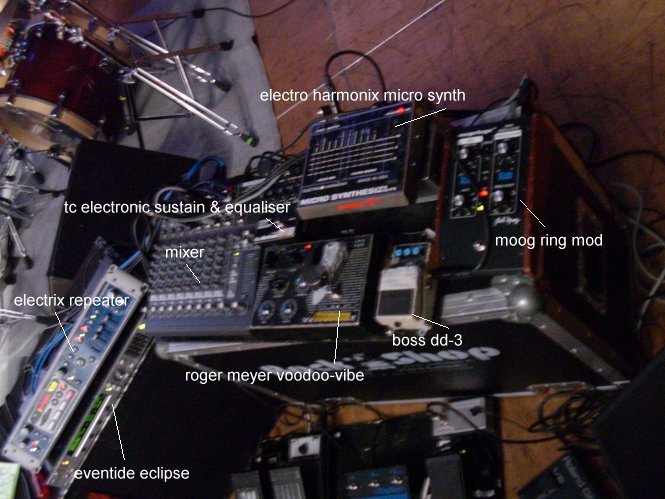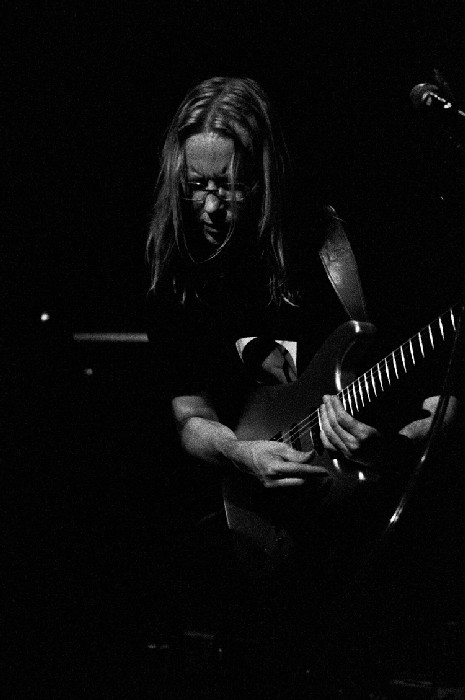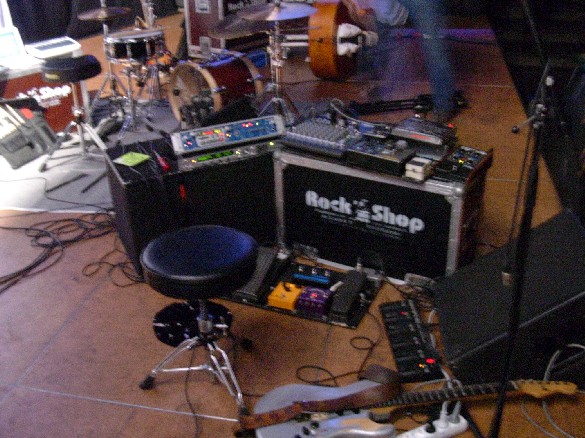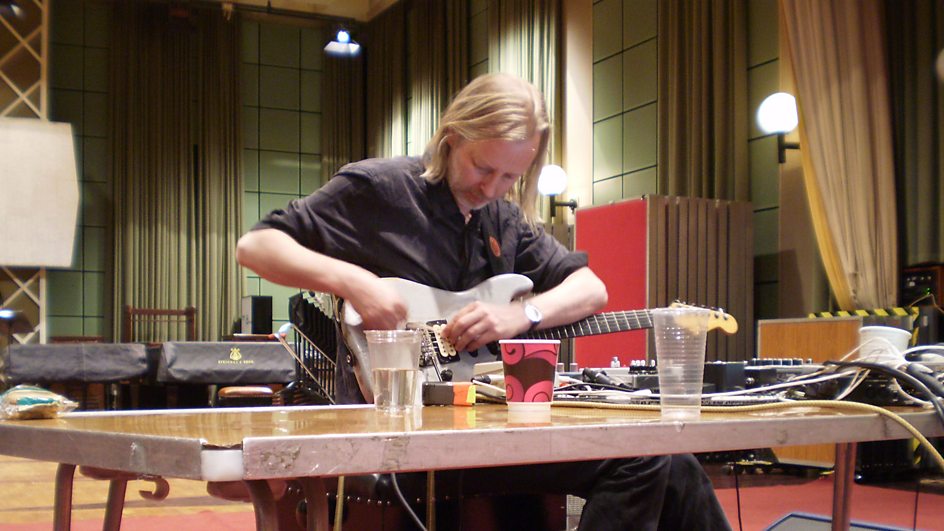| Eivind Aarset | |
By
Barry Cleveland
|
|
Wed, 1 Dec 2010
|
|
 Norwegian guitarist and composer Eivind Aarset occupies a self-created sonic space spanning jazz, rock, ambient, electronic, dance, avant-garde, and numerous ethnic musical realms. Aarset was first drawn to the electric guitar after hearing Jimi Hendrix—and Sabbath, Purple, Zeppelin, and Floyd were among his other early influences. His next major “eye-opener” was Miles Davis’ Agharta, featuring Pete Cosey and Reggie Lucas on guitars, an album that led to Aarset’s discovery of fusion bands such as the Mahavishnu Orchestra, and ECM jazz artists such as fellow Norwegian guitarist Terje Rypdal. After a stint in a heavy metal band in the early ’80s, Aarset spent a decade as a studio musician, playing on hundreds of recordings (including albums by Cher and Ray Charles).  The guitarist’s latest release, Live Extracts [Jazzland], by Eivind Aarset & the Sonic Codex Orchestra, is a phenomenal concert recording featuring a six-piece band comprising dual drummers, bass, trumpet, and a second guitarist who doubles on pedal-steel. The material includes entirely new, improvisation- friendly, arrangements of earlier pieces recast for the current instrumentation. Aarset has also begun work on an album of guitar-only orchestrations.  Not really. We play mostly at jazz festivals, and my records are in the jazz department of the record stores, but I think of myself as more of an improvising rock musician. There is jazz in there, and I love classic jazz guitarists such as Joe Pass and Herb Ellis, but that isn’t really what I do. Have you been using effects since you began playing? Yes, though back then I was pretty much limited to fuzz, wah, tape echo, and a volume pedal. Then, in the ’80s, like everyone else I began using huge racks of effects. Now I’m just using pedals again, partly because I prefer not to have to program all of that stuff. Would you say that sonics are as significant in your music as harmonic structure? While it is true that I have always been interested in extending the sound of the instrument, for me the great thing is when the sounds and the harmonic structures melt together. And, of course, the same harmonic structures may sound entirely different depending on the sounds you use, or whether you play them on a guitar or a piano or with a string section.  Step us through your current live signal chain. I have two pedalboards, one I control with my hands and another I control with my feet. My guitar goes into a Lehle D.Loop SgoS Effect Looper/Switcher, which has two loops. Loop A contains a Prescription Electronics Experience Octave/Fuzz, a Dunlop wah, a Boss OD- 2 Turbo OverDrive, and a Rat distortion. Loop B contains a Boss DD-5 Digital Delay, an Alesis Bitrman ModFX multi-effects processor, a Z.Vex Fuzz Factory, and an Electro- Harmonix Micro Synthesizer. The output of the Lehle goes to a Morley volume pedal, an Eventide PitchFactor, a Line 6 DL4 Delay Modeler, and a pair of GigRig HumDinger signal splitters that I use to send a mono feed to my amp—which is usually a Vox AC30—and a stereo feed to a MOTU Traveler FireWire Audio Interface and a MacBook running Ableton Live. I also have three Roland EV-5 expression pedals: One controls Feedback and Delay Level on the DL4, another controls various functions on the PitchFactor, and the third one is connected to a Logidy USB foot controller that I use along with a Korg nanoKONTROL to make real time adjustments in Live.  What’s an example of a pedal you control with your hands? A good example would be the Boss DD- 5 delay, which has some very nice algorithms. I keep it on all the time with the feedback turned all the way up and the delay volume turned down. At certain points I’ll bring up the delay volume and listen to what is there. If I have it set to the Reverse mode, I can alter the pitch by changing the delay length, and when it is in the Delay mode, changing the delay length will digitally mangle whatever sounds have been recorded. You have several distortion pedals. Do you combine them? Yes, all the time. I use the software looper in Live and control it with the Logidy and the nanoKONTROL. Normally I have three loops set up for recording, but each loop can have as many layers as I want, and the loops can be mixed differently and be of different lengths.  When I first started doing solo albums, I was more into electronics and programming, but that has changed gradually as I’ve been touring. For this album I decided not to use any electronic beats or pre-recorded sounds. That gives the drummer much more freedom, and gives the music a more organic feel. The arranging process also involved taking things away. I wanted the musicians to be as free to go in different directions as possible, without having to think too much about executing difficult parts, so there would be space for communication and getting involved with the audience.  Why did you choose to work with pedal-steel? I think it has a beautiful sound, and I love what players like Daniel Lanois and Paul Franklin do with it. My friend Bjorn Charles Dreyer, who plays guitar and pedal-steel on the album, hasn’t played the instrument very long, and I hadn’t really thought much about using it before we began rehearsals—but I really loved the sound. What kind of guitar do you play? A Norwegian luthier named Jan Braahten built my guitar. He made everything on the instrument with the exception of the pickups, which were made by another Norwegian named Knut Myhrvold. The guitar is very much like a Stratocaster, though it has a piezo pickup with a separate volume control and output. The piezo is built into the body rather than the bridge, and picks up sounds I make when touching and manipulating the instrument in various ways. It gets routed directly into my laptop. What strings and picks do you use? I use DR strings gauged .010-.046 most of the time, and Dunlop Jazz I picks. Do you play exclusively with a pick or do you sometimes also use your fingers? I sometimes combine the pick with my fingers, particularly my thumb, which I use to get a softer attack. Do you ever play in open or alternate tunings? I only play in standard tuning. Whenever I’ve tried to play in other tunings I’ve just gotten very confused. Describe your philosophy regarding improvisation. I try to be inside the music as far as that is possible. I am very happy in those moments when I can relax and feel how the different sounds are working both with the other musicians and within the room. Each sound has an emotional impact, and when creating sounds I am always trying to use that energy to go from one place to another, and to go there with the other musicians and the audience. Also, my improvisations are more modal than harmonically based—though chords may be built from those scales and modes. Is there anything that you do to get yourself in the right frame of mind for improvising? No. I wish that were the case, but I don’t have any technique or ritual for that purpose. I always feel more relaxed when there is the opportunity for a good sound check, but that’s not a rule, because sometimes the sound check will be great and the gig will be awful, and sometimes there will be no sound check at all and the gig will be beautiful. Another variable is the energy between the musicians and the audience—the communication between us as we are creating something together. In what ways did Terje Rypdal’s guitar playing and music influence you? Rypdal has this really strong tone and sense of musical identity that I’ve always liked very much. Another important thing for me was that he came to jazz from the rock world. He played with jazz musicians, but he was very brave in his approach—putting himself inside the music, without trying to be a jazz musician. That he came up with his own thing and had success outside Norway was, of course, also very inspiring. What have you taken away from the experience of working with Jon Hassell? I was introduced to his music when I heard Power Spot in the ’80s. I loved it immediately, but it sounded so different than anything I had heard before that I wasn’t able to figure out what he was doing. One important thing I’ve learned from being on stage with him is having patience as the music progresses. For example, the way he thinks of his melodic phrases: He’ll start a phrase and then he might leave a long space before concluding it. In terms of actually understanding the harmonic world he lives in—the scales, chords, and layers of sound—we have talked about those things, but I still don’t know if I really understand his music |
